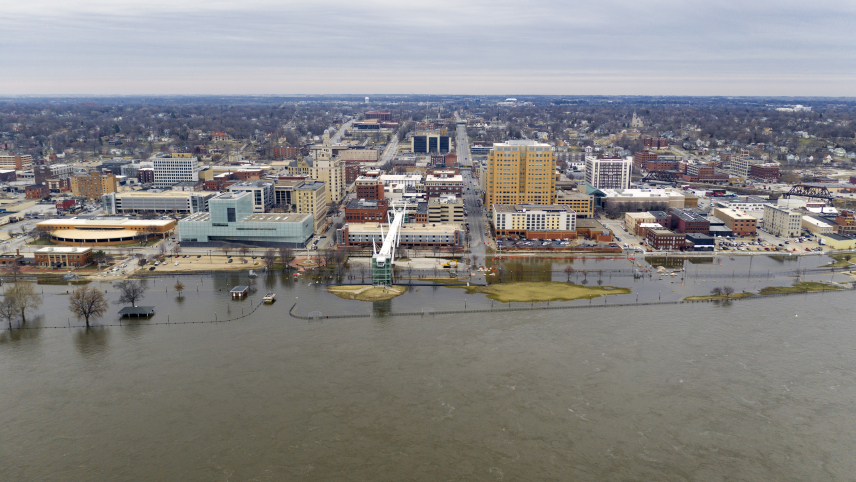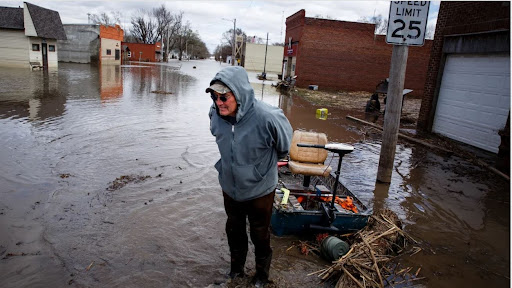NOAA partnered with the Cooperative Institute for Research to Operations in Hydrology, through the University of Minnesota, to develop a pilot project focused on two objectives:
- Increase understanding of long-term flow patterns of the Upper Mississippi River to provide data on how the river will likely respond to changing climate conditions.
- Develop customized community engagement strategies for vulnerable communities to enhance their climate resilience. Such strategies will focus on collaboratively building long-term, respectful partnership and relationships with underserved communities.
Overall, this work is intended to improve the understanding, interpretation, and use of these forecasts and hydrological data products and services to improve preparedness and resilience.

Dual Needs: Science and Community Engagement
A changing and more variable climate has significant impacts that change community risk to hydrologic events. For example, more intense precipitation leads to higher acute streamflow peaks that increases the flood risk to communities, and especially communities that are disproportionately affected, underserved, and have vulnerable populations.
This means that reducing community risk requires both spatially and temporally relevant hydrologic predictions given climate change and developing an effective community engagement strategy that centers social equity and ensures engagement that reduces the impact of hydrologic event risk for those people who are most vulnerable. Long-term, this work is intended to improve the understanding, interpretation, and use of forecasts, hydrological data products and services - which will improve preparedness and resilience.
The project team includes both climate experts and social science experts. The social science (or community engagement) team has a well-established track record of effective collaboration with NOAA and the production of social science research that has been operationalized by NOAA forecast producers. The climate modeling team has expertise in statistical and dynamical downscaling climate models in the Upper Mississippi River basin region and making the data widely and freely available for a range of research, translational, and operational uses.
Science Team
The objective of the study is to produce a downscaled climate projections dataset that will be integrated to produce a report on Upper Mississippi River Basin flows, 90 years into the future, using widely accepted climate change model output. The report will detail how future basin flow conditions may change over time to allow community stakeholders to better understand the risks of flow pattern change, changes in variability, and changes in extreme events
Current Progress includes:
- Completed identification of downscaled climate data for use (NASA CMIP6)
- Created preliminary systems workflow to get modeling structures to interact (have preliminary river simulations at select points)
- Working to bridge gaps between spatial and temporal resolutions
- Choosing final ensemble of climate change models and scenarios
- Choosing “benchmark” analysis sites
Next steps:
- Technical stakeholder engagement will begin this summer to understand science and modeling used with existing state, local, and private sector groups. This will inform what types of final products will be useful.
- Continued discussions on trend analysis to tie into other NOAA and federal agency efforts throughout the basin.
Above and Beyond:
The work underway by the science team includes results that are above and beyond meeting the initial objectives. The inclusion of land contributions in hydrograph output is considered very innovative (particularly when looking at future applications and incorporating flow impacts related to human driven changes). Also noteworthy is the development of practical workflows which integrate statistically downscaled climate models allows for more efficiency and integration into existing NWS River Forecast Center models.

Community Engagement Team
In addition to climate and hydrological modeling to assess the changes in hydrologic variables such as streamflow, this pilot includes social science research approaches and best practices to engage historically excluded community members. Results will lead to a new regional data product, community partnerships, and publications that will better support community flood risk mitigation strategies. The Team's engagement efforts include development of non-traditional partnerships and engagement with marginalized communities, as well as user-centered decision support tool development to empower a wider range of audiences to engage with hydrologic NOAA data products. A focus on science will be utilized as the approach to bring people together, within an a-political space, to foster a participatory process with an effort to find commonality, empower use of existing systems, and ensure shared understanding throughout the region.
Current Progress:
- Expansive stakeholder identification is now complete.
- Identified existing mapping efforts conducted or underway which will be able to be leveraged to understand communities impacted by floods (and potentially droughts).
- Developed approach and bid process to engage a wider range of traditional and non-traditional partners - which will allow expansion of engagement.
Next Steps:
- Selected communities to to start engaging with deeper, leveraging partnerships to ensure successful engagement.
- Complete a communications strategy to support regional engagement around the hydrologic model outputs including workshops, focus groups or interviews and broad regional dissemination of results and its potential use through our regional stakeholder partners.
For more background information on the NOAA Central Region Pilot, check out this Press Release. Information on pilot projects in other regions is available here.


